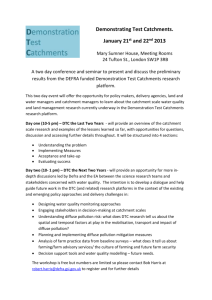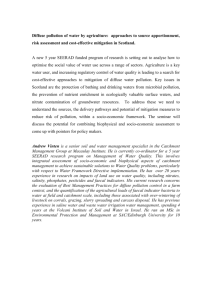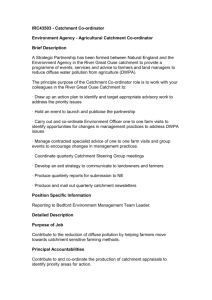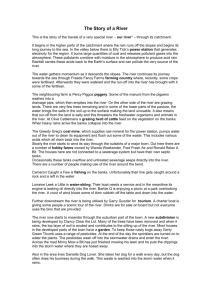DTC Objectives - National Demonstration Test Catchments Network
advertisement
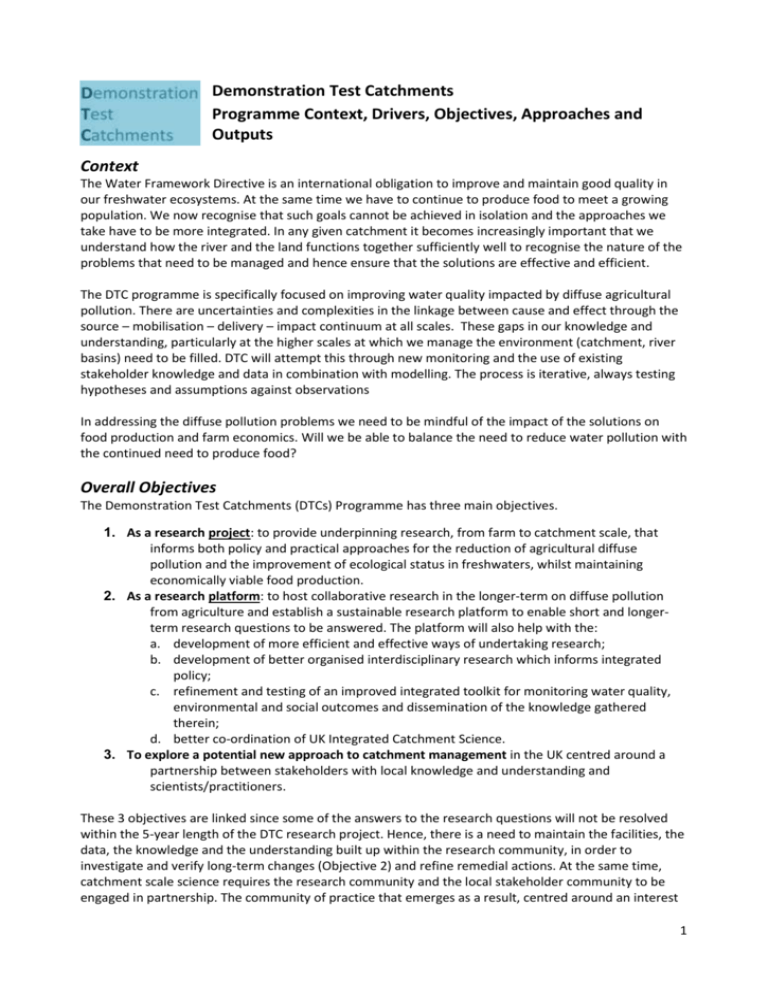
Demonstration Test Catchments Programme Context, Drivers, Objectives, Approaches and Outputs Context The Water Framework Directive is an international obligation to improve and maintain good quality in our freshwater ecosystems. At the same time we have to continue to produce food to meet a growing population. We now recognise that such goals cannot be achieved in isolation and the approaches we take have to be more integrated. In any given catchment it becomes increasingly important that we understand how the river and the land functions together sufficiently well to recognise the nature of the problems that need to be managed and hence ensure that the solutions are effective and efficient. The DTC programme is specifically focused on improving water quality impacted by diffuse agricultural pollution. There are uncertainties and complexities in the linkage between cause and effect through the source – mobilisation – delivery – impact continuum at all scales. These gaps in our knowledge and understanding, particularly at the higher scales at which we manage the environment (catchment, river basins) need to be filled. DTC will attempt this through new monitoring and the use of existing stakeholder knowledge and data in combination with modelling. The process is iterative, always testing hypotheses and assumptions against observations In addressing the diffuse pollution problems we need to be mindful of the impact of the solutions on food production and farm economics. Will we be able to balance the need to reduce water pollution with the continued need to produce food? Overall Objectives The Demonstration Test Catchments (DTCs) Programme has three main objectives. 1. As a research project: to provide underpinning research, from farm to catchment scale, that informs both policy and practical approaches for the reduction of agricultural diffuse pollution and the improvement of ecological status in freshwaters, whilst maintaining economically viable food production. 2. As a research platform: to host collaborative research in the longer-term on diffuse pollution from agriculture and establish a sustainable research platform to enable short and longerterm research questions to be answered. The platform will also help with the: a. development of more efficient and effective ways of undertaking research; b. development of better organised interdisciplinary research which informs integrated policy; c. refinement and testing of an improved integrated toolkit for monitoring water quality, environmental and social outcomes and dissemination of the knowledge gathered therein; d. better co-ordination of UK Integrated Catchment Science. 3. To explore a potential new approach to catchment management in the UK centred around a partnership between stakeholders with local knowledge and understanding and scientists/practitioners. These 3 objectives are linked since some of the answers to the research questions will not be resolved within the 5-year length of the DTC research project. Hence, there is a need to maintain the facilities, the data, the knowledge and the understanding built up within the research community, in order to investigate and verify long-term changes (Objective 2) and refine remedial actions. At the same time, catchment scale science requires the research community and the local stakeholder community to be engaged in partnership. The community of practice that emerges as a result, centred around an interest 1 in, and understanding of the river and its interaction with the land, is the basis of a form of Integrated Catchment Management (ICM) (Objective 3). OBJECTIVE 1 As a research project: to provide underpinning research, from farm to catchment scale, that informs both policy and practical approaches for the reduction of agricultural diffuse pollution and the improvement of ecological status in freshwaters, whilst maintaining economically viable food production. Drivers (Why): Many of our waterbodies are currently impacted by pollution (only 27% of water bodies in England and Wales are at good ecological status). We have obligations through EU and national legislation to address this gap. We know that agriculture is responsible for some of this problem (in the UK 60% of nitrates, 25% of phosphorus and 75% of sediments polluting water bodies come from farming1 and approximately 40% of water bodies are currently at risk of failing to meet good ecological status due to agriculturally-derived water pollution) At the same time, society faces major challenges to feed a growing global population in the face of dwindling resources and a changing climate. Defra is committed to: o support and develop British farming and encourage sustainable food production and o help to enhance the environment and biodiversity and to improve quality of life. Diffuse agricultural water pollution and its effects on aquatic ecology remain relatively poorly understood. The evidence that we have to support specific mitigation measures is largely based on plot-scale experimentation – we do not fully understand how measures behave in combination or when applied over larger catchment scales. We wish to predict the effectiveness of mitigation measures at locations which may be spatially and/or temporally distant from both the source of pollution and the point at which we measure the quality or status of the freshwater. Approach (How): DTC establishes a nationally co-ordinated programme of work focused on three specific areas, representative of land use and farming practice across England and Wales. It takes a two-pronged approach to improve our understanding of diffuse agricultural pollution and the effectiveness of mitigation measures as illustrated in Figure 1 below. 1. Measures It will establish land use and mitigation measures within targeted areas and compare water quality changes against “business as usual” control areas. Water quality data, collected at nested spatial scales, will be interpreted together with farm practice information using a range of statistical approaches. These will be used to assess the effectiveness of manipulation in target areas and provide evidence on the effectiveness of agricultural diffuse pollution mitigation measures at the farm to catchment scale. The statistical interpretation of the conventional water quality data will be undertaken within the context of a wider toolkit for assessing environmental and social outcomes in the DTCs. The use of the toolkit will permit a ‘weight of evidence’ approach for supporting improved recommendations for mitigating diffuse water pollution from agriculture. Further work within the platform will be commissioned through Component 2 (Measures) and will collect field/farm scale data using a range of experimental designs and technologies to provide information on the cost-effectiveness of individual measures. 1 http://www.foodsecurity.ac.uk/issue/facts.html#refs 2 2. Catchment characterisation Monitoring activities in the DTC programme will provide quantitative and qualitative evidence that will provide an improved conceptual understanding of catchment processes, including the sources, pathways and receptors driving diffuse pollution from agriculture to support future modelling activities to achieve the purposes highlighted above. This is the first time that it has been done simultaneously in a coordinated national effort across a range of typologies for England and Wales. Figure 1: DTC will undertake parallel work on understanding catchment processes, through river catchment characterisation, and testing the effectiveness of mitigation measures. These will provide information to inform future modelling and policy development. Specific objectives are to understand: The processes affecting pollutants as they propagate throughout the catchment – whether via the subsurface, shallow drainage or across land and whilst in transport downstream (including macro-nutrient cycling, transformations and attenuation). The spatial and temporal scales at which interventions can reduce the impact of agricultural diffuse pollution on water quality, ecology and other receptors across catchment scales and how these fit with policy perspectives. Temporal scales include short (acute) and long term (chronic) responses. The win-wins and trade-offs necessary in selecting mitigation strategies. The social and economic actions necessary to improve the adoption of effective mitigation measures. The improved integration of different data and information into a unified conceptual model of the linkages between water quality and the supporting, provisioning, regulating and cultural ecosystem services (as defined by the Millennium Ecosystem Assessment 2). This will underpin the development of appropriate modelling tools. These objectives will be informed by data collected on: 2 Pollutant levels in rivers and groundwater at multiple, nested spatial scales. http://www.ecosystemservices.org.uk/ecoserv.htm 3 Impacts on freshwater ecology (ecosystem process rates and community assessments). The economics and practicality of implementation. Impacts on agricultural productivity. Other benefits and impacts (e.g. the impact of measures on flooding, greenhouse gas emissions and terrestrial biodiversity). Interactions between multiple environmental, social and economic factors. Suites of diffuse pollution mitigation measures according to: o Effectiveness: Identify and demonstrate the cost-effectiveness of pollution mitigation options. o Lifespan: Assess the lifespan of mitigation measures (to determine short and long term fixes). o Management of measures: Develop guidance on maintenance required to maintain effectiveness. o Interactions: Test conflict/ interaction between measures o Uptake: How do we quantify uptake, barriers to uptake and socio-economic implications of mitigation options? o Targeting: Improve the spatial and temporal targeting of diffuse pollution mitigation measures through modelling and risk mapping to identify priority areas and optimise pollution reduction. The programme will co-ordinate closely with other relevant projects and programmes in fulfilling its goals. It is therefore a means of focussing effort that has been otherwise distributed across a range of research sites in a rather ad hoc and disparate manner. Outputs/Success Criteria Costs and Benefits – Component 2 (Measures) will provide robust quantification of the real and marginal costs and benefits of approaches to diffuse pollution mitigation. Evidence and communication – A range of on-farm measures to bring changes in water quality/ecosystem that policy-makers and industry have confidence in. – Uncertainties are well understood and communicated. – Development of a robust and transferable integrated toolkit for monitoring freshwater systems and their social dimensions to determine consequential changes in water quality / aquatic ecology from changing land management practices. – Clear, evidence-based messages on the relationship between land management and the environment are developed. Policy and industry stakeholders have confidence in these messages. Tools and guidance – Models, decision support systems and guidance is developed to inform decision making by farmers, policy makers, delivery bodies and other stakeholders. OBJECTIVE 2 As a research platform: to host collaborative research in the longer-term on diffuse pollution from agriculture and establish a sustainable research platform to enable short and longer-term research questions to be answered. The platform will also help with the: development of more efficient and effective ways of undertaking research; development of better organised interdisciplinary research which informs integrated policy; 4 refinement and testing of an improved integrated toolkit for monitoring water quality, environmental and social outcomes and dissemination of the knowledge gathered therein; better co-ordination of UK Integrated Catchment Science. Drivers Policy focused research related to water quality is commissioned and managed by a number of groups (at least 10) in the UK across government departments, devolved administrations and delivery agencies. Basic science relevant to these programmes is also funded by several Research Councils. This research is relevant to a broad range of related policy areas. There is considerable scope to improve coordination between science programmes to answer cross cutting research questions and achieve better value for money. The limited nature of resources available to Defra and the EA sets challenges both in terms of funding research on large geographical and temporal scales, and employing the human resources necessary to maintain a focus on policy priorities and to disseminate relevant information. Regular staff turn-over in science and policy teams limits the “corporate memory” of science that has been funded in the past. This increases the risk of repeating research that has already taken place and has adversely affected the efficiency with which R&D outputs have been translated into evidence based policy. Conversely, staff in research organisations are generally stable and hold much of the knowledge and “corporate memory” that Defra relies on to inform policy. This knowledge is currently often accessed through small consultancy contracts and the commissioning of ad hoc review projects to distil information from research into outputs that are accessible to policy makers. Purpose The Defra Evidence and Innovation Strategy sets out the need to develop multidisciplinary research that takes into account the interdependencies, trade-offs and interactions between food production and ecosystem services whilst adapting to the effects of climate change. There is a need to set the conditions to support such collaborative and interdisciplinary work by facilitating linkages between research groups. Clear communication of research that takes into account these interactions can be presented in a coordinated fashion to policy teams across Defra to inform efficient policy making. Approach An alternative model for commissioning, managing and translating policy relevant R&D has been developed for the Farming and Food Science Sustainable Water Management Programme and is being tested through the DTC programme. The DTC programme will establish a “research platform” or “outdoor laboratory” consisting of: A national network of catchment-scale study sites. These sites will collect appropriate temporal and spatial data in a consistent manner from monitoring arrays that cover groundwater, surface water, flow and ecology. Data will be collected to meet the objectives above. Co-ordinated catchment-science research activities. Currently disparate research on interrelated impacts of agriculture on the environment will be linked through the DTC programme. Researchers will work closely with wider stakeholder groups using existing data, information and knowledge more effectively to provide a more robust evidence base. There will be a co-ordinated approach to the development and calibration of improved modelling tools to assess the viability of defined policy interventions for achieving targets through the compilation of a series of robust and accessible datasets. An integrated data infrastructure allowing others to freely use the data and information to promote collaboration in research and analysis. Working closely with the NERC Pilot Virtual 5 Observatory, this will contribute to wider NERC objectives in developing innovative new ways of collecting and making available experimental data through the use of remotely controlled monitoring instrumentation and web-based data portals to ensure that data can be managed and disseminated efficiently and effectively. This will, in turn, underpin the development of unified data analysis and modelling solutions describing and forecasting relevant processes and transformation across scales. The DTC research platform will act as a focal point for catchment research to improve linkages with wider UK and international research activities including research council programmes (e.g. BBSRC and NERC) and programmes being taken forward by devolved administrations and other EU member states (e.g. Scottish Monitored Priority Catchments and the Irish Agricultural Catchments project). It will establish a community of researchers, policy makers, delivery bodies and other stakeholder groups who are developing a shared understanding of the policy challenges, evidence gaps and practical implications of addressing diffuse agricultural pollution in the context of wider objectives and ecosystem services which land management is expected to provide. The DTC platform will offer a flexible and adaptive approach to providing evidence to policy. The platform will draw in resources from other funders by providing field sites, equipment, data and expertise. It will be able to host low cost reactive projects to answer immediate policy questions whilst building up long-term datasets to improve our conceptual understanding of catchment processes. Outputs/Success Criteria Strong consortia – Well established consortia with a mix of all relevant disciplines fully engaged on environmental and social outcomes. – The majority of key academics and research institutions are engaged. – Local consortia build institutional capacity and develop their own work programmes and are successful in bidding into other funding sources. Co-operation and Collaboration – Consortia have strong and sustainable working relationships with local stakeholder groups. – Farmers within study areas collaborating with the project. – DTC and research councils are collaborating well delivering added value through links to other projects and programmes (e.g. NERC Pilot Virtual Obervatory, NERC Changing Water Cycle, NERC Macronutrient Cycling Programme). Sustainability – Total funding grows based on the research platform and demonstration catchment concepts. OBJECTIVE 3 To explore a potential new approach for catchment management in the UK centred around a partnership between stakeholders with local knowledge and understanding and scientists/practitioners. Drivers Big society A need to take an ecosystems approach that takes account of multiple factors. A need to involve the community, farmers and key stakeholders in the process in order to make changes happen. Purpose By developing a community around researchers and other stakeholders with knowledge, the Consortia will explore a different approach to environmental management and governance than current practice. 6 Operating at the scale of the river catchment or sub-catchment techniques for stakeholder engagement, mechanisms for influencing key stakeholders and ways of sharing information between local actors will develop that will be helpful in the implementation of the Water Framework Directive. One of the key challenges facing the implementation of the WFD, and more broadly the development of ICM, is to connect top-down, largely government-led processes operating at regional, national and even international scales, with local energy and activity operating at smaller scales. We hope that the models that will develop over the life of the DTC Programme will aid our understanding of how to connect the levels of governance better through experimenting with facilitating mechanisms such as farmer groups and other local community organisations. Approach The approach will be more integrated, inclusive, participatory, adaptive and collaborative. One term for this is Integrated Catchment Management (ICM) a definition of which is: “a process that recognises the catchment as the appropriate organising unit for understanding and managing ecosystem goods and services in a context that includes social, economic and political considerations, and guides communities towards an agreed vision of sustainable land and water resource management for their catchment.” This objective will be delivered through the Knowledge Exchange component of the DTC Programme (Component 3). Outputs/Success Criteria Influence and transferability – Evidence on the effectiveness of different methods for influencing behaviour and communicating information. – Mechanisms to encourage bottom-up involvement of farmers and stakeholders in prioritising land management approaches are established and tested – a ‘big-society’/ integrated catchment management approach. – Results are transferable to other catchments and other situations. – Demonstration activities lead to landowners outside of the test areas taking up new land management approaches. 7 Expected outcomes Water quality and ecological quality monitoring strategies in the Demonstration Test Catchments need careful design to ensure that they can detect changes despite temporal and spatial effects. It is essential for the design to understand what can and what cannot be achieved within the funding span of the DTC and what has to be undertaken as a longer-term research platform. DTCs are using a range of approaches to optimise the best possible evidence for informing policy decisions on water quality. It benefits substantially from the national level coordination, that for the first time attempts to harmonise approaches across a range of landscape typologies in England and Wales. In order to set this in place the level of investment is necessarily high, especially in equipment and infrastructure. Against this backdrop, it is important to be realistic about expected outcomes. Each of the individual DTCs are undertaking a nested approach to monitoring. Social, economic and behavioural factors are included as well as environmental ones to help demonstrate the effectiveness of measures in shorter timeframes (see table below). Table 1: Monitoring at different scales to detect short and long term effects of diffuse pollution mitigation measures. Timeframe 1 year Outcomes Measuring Social science, attitudes and behaviour Uptake of measures Predicting Initial conceptual modelling to predict effectiveness of measures Demonstrating The development of approaches to integrated catchment research The efficiencies and effectiveness of working collaboratively through research consortia 5 years Measuring Reductions in pollutant delivery at small spatial scales (towards the source/ mobilisation of the delivery continuum and at field / farm scale) The effect of measures on economic and agronomic farm performance Pollutant fluxes, flow-weighted mean concentrations, instantaneous concentrations etc and variations at sub-catchment outlet and how they relate to precipitation events Source apportionment changes linked to targeted mitigation Providing catchment attribute, practice and activity data to underpin conceptual and predictive modelling Changes in ecosystem process rates 8 10-20 years Predicting Improving conceptual models of key catchment processes (in specific areas of catchments where the investment and learning is high) Improving certainty in detecting real impacts due to the effectiveness of measures on pathways and receptors Improved catchment modelling capabilities and a greater understanding of the uncertainty therein Ability to extrapolate information to other parts of the country Robust quantification of the real and marginal costs and benefits of on-farm approaches to diffuse pollution mitigation. Demonstrating A range of on-farm measures to bring changes in water quality/ecosystem that policy-makers and industry have confidence in. Cost and practicability of measures with an improved ability to predict effectiveness A robust and transferable integrated toolkit for monitoring freshwater systems to determine consequential changes in water quality from changing land management practices. Communicating the issues to key stakeholders Clear, evidence-based messages on the relationship between land management and the environment are developed. Measuring Measuring positive changes in water quality at sub-catchment outlets Measuring positive ecological changes (understanding receptors) Predicting Understanding catchment processes and hysteresis (understanding pathways) Demonstrating Clear messages to farmers and their advisers on diffuse pollution, its impacts and mitigation Clear guidance on best practice Successful ‘communities of practice’ 9
